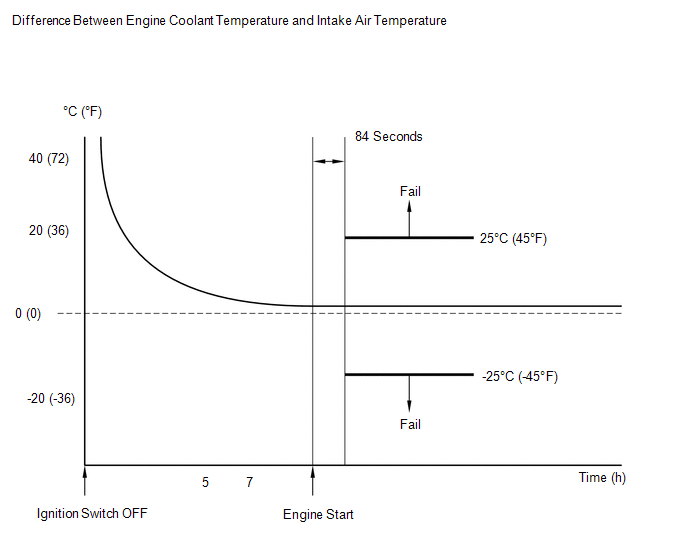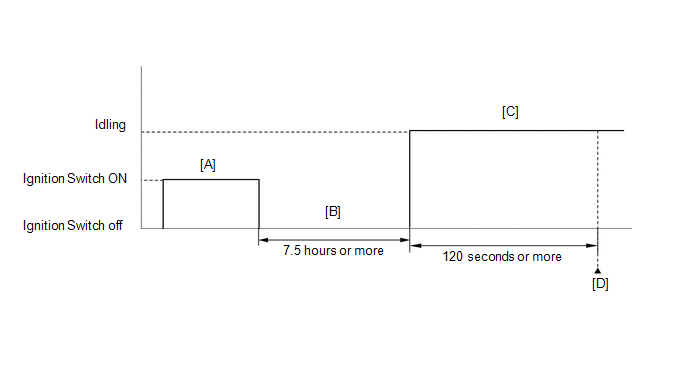DESCRIPTION The engine has
two temperature sensors, an Engine Coolant Temperature (ECT) sensor and
an Intake Air Temperature (IAT) sensor, to detect temperature while the
engine is in operation. A thermistor, whose resistance value varies
according to temperature, is built into each sensor. When the
temperature is low, the resistance of the thermistor increases. When the
temperature is high, the resistance drops. These variations in
resistance are transmitted to the ECM as voltage changes. Based on these
temperature signals output from the sensors, the ECM determines the
fuel injection time and the ignition timing to control the engine. |
DTC Code | DTC Detection Condition |
Trouble Area | | P011B |
- All of the following conditions are met (2 trip detection logic):
- The battery voltage is 10.5 V or higher.
- 7 hours or more have elapsed from engine stop on the previous trip.
- 84 seconds after a cold engine start.
- The minimum Intake Air Temperature (IAT) after the engine starts is higher than -10°C (14°F).
- The average Engine Coolant Temperature (ECT) before the engine starts is higher than -10°C (14°F).
- The result of (ECT - IAT) is outside of the range of -25 to 25°C (-45 to 45°F).
|
- IAT sensor
- ECT sensor
- ECM
|

HINT:
- Waiting is required to prevent the temperature of the engine from
affecting the readings. If the engine has been operated recently, it
will not be possible to accurately compare the readings.
- For diagnosis, in order to duplicate the detection conditions of the
DTC, it is necessary to park the vehicle for 7 hours. Parking the
vehicle for 7 hours ensures that the actual temperature of the ECT and
IAT are very similar. When the vehicle has been parked for less than 7
hours, differences in the readings may exist. However, this does not
necessarily indicate a fault.
MONITOR DESCRIPTION The
ECM monitors the difference between the Engine Coolant Temperature
(ECT) and the Intake Air Temperature (IAT) when the engine is started
cold to detect the engine temperature conditions accurately. The monitor
runs when the engine is started cold after 7 hours or more have elapsed
since the engine was stopped (ignition switch turned off) on the
previous trip. If the difference between the engine coolant temperature
and the intake air temperature on a cold start is 25°C (45°F) or more,
or if the engine coolant temperature is more than 25°C (45°F) lower than
the intake air temperature, the ECM interprets this as a malfunction in
the engine coolant temperature sensor circuit and intake air
temperature sensor circuit, and sets the DTC. MONITOR STRATEGY |
Related DTCs | P011B: Engine Coolant Temperature (ECT) / Intake Air Temperature (IAT) sensor correlation | |
Required Sensors/Components (Main) | ECT / IAT sensor | |
Required Sensors/Components (Related) |
- | | Frequency of Operation |
Once per driving cycle | | Duration |
- | | MIL Operation |
2 driving cycles | | Sequence of Operation |
None | TYPICAL ENABLING CONDITIONS |
The monitor will run whenever these DTCs are not stored |
P0102, P0103 (Mass air flow meter) P0112, P0113 (Intake air temperature sensor)
P0115, P0117, P0118 (Engine coolant temperature sensor) P0125 (Insufficient coolant temperature for closed loop fuel control)
P2610 (ECM internal engine off timer) | |
All of following conditions met | - | |
1. All of following conditions met | Conditions (a), (b), (c) and (d) | |
(a) After ignition switch ON and engine not running time |
Less than 20 seconds | | (b) Soak time |
7 hours or more | | (c) Battery voltage |
10.5 V or higher | | (d) Time after engine start |
84 seconds or more | | Either of the following conditions are met |
Condition (a) and (b) | | (a) Minimum IAT after engine start |
-10°C (14°F) or higher | | (b) ECT before engine start |
-10°C (14°F) or higher | TYPICAL MALFUNCTION THRESHOLDS |
Temperature deviation (difference between ECT and IAT) |
More than 25°C (45°F) or less than -25°C (-45°F) | CONFIRMATION DRIVING PATTERN

- Connect the Techstream to the DLC3.
- Turn the ignition switch to ON and turn the Techstream on.
- Clear DTCs (even if no DTCs are stored, perform the clear DTC operation) [A].
- Turn the ignition switch off.
- With the engine stopped, leave the vehicle as is for 7.5 hours or more [B].
- Start the engine and wait 120 seconds or more [C].
- Enter the following menus: Powertrain / Engine and ECT / Trouble Codes [D].
- Read the pending DTCs.
HINT:
- If a pending DTC is output, the system is malfunctioning.
- If a pending DTC is not output, perform the following procedure.
- Enter the following menus: Powertrain / Engine and ECT / Utility / All Readiness.
- Input the DTC: P011B.
- Check the DTC judgment result.
|
Tester Display |
Description |
|
NORMAL |
- DTC judgment completed
- System normal
|
|
ABNORMAL |
- DTC judgment completed
- System abnormal
|
|
INCOMPLETE |
- DTC judgment not completed
- Perform driving pattern after confirming DTC enabling conditions
|
|
N/A |
- Unable to perform DTC judgment
- Number of DTCs which do not fulfill DTC preconditions has reached ECU memory limit
|
HINT:
If the judgment result shows INCOMPLETE or N/A, perform steps [A] through [D] again.
- If no pending DTC is output, perform a universal trip and check for permanent DTCs (See page
 ). ).
HINT:
- If a permanent DTC is output, the system is malfunctioning.
- If no permanent DTC is output, the system is normal.
PROCEDURE |
1. | CHECK ANY OTHER DTCS OUTPUT (IN ADDITION TO P011B) |
(a) Connect the Techstream to the DLC3. (b) Turn the ignition switch to ON.
(c) Turn the Techstream on. (d) Enter the following menus: Powertrain / Engine and ECT / Trouble Codes.
(e) Read DTCs. |
Result | Proceed to | |
P011B output | A | |
P011B and other DTCs output |
B | HINT: If any DTCs other than P011B are output, troubleshoot those DTCs first.
| B |
 | GO TO DTC CHART |
|
A |
 | |
| 2. |
READ VALUE USING TECHSTREAM (INTAKE AIR TEMPERATURE) |
(a) Leave the vehicle for 7 hours or more. HINT: It is necessary leave the vehicle for 7 hours or more to create conditions similar to the DTC detection conditions.
(b) Connect the Techstream to the DLC3. (c) Turn the ignition switch to ON.
(d) Turn the Techstream on. (e) Enter the following menus: Powertrain / Engine and ECT / Data List / Intake Air.
(f) Read the value displayed on the Techstream. OK: Difference between the intake air temperature and the actual outside air temperature is within 10°C (18°F).
HINT:
- Temperature readings on the vehicle outside temperature gauge (if
equipped) are not suitable for comparison with the IAT reading. The
outside temperature gauge has a significant delay built-in to prevent
temperature swings from being displayed on its display. Use an accurate
thermometer to determine the outside air temperature.
- Perform "Inspection After Repair" after replacing the mass air flow meter (See page
 ). ).
| NG |
 | REPLACE MASS AIR FLOW METER |
|
OK |
 | |
| 3. |
READ VALUE USING TECHSTREAM (COOLANT TEMPERATURE) |
(a) Connect the Techstream to the DLC3. (b) Turn the ignition switch to ON.
(c) Turn the Techstream on. (d) Enter the following menus: Powertrain / Engine and ECT / All Data / Coolant Temp.
(e) Read the value displayed on the Techstream. OK: The difference between the coolant temperature and the actual outside air temperature is within 10°C (18°F).
HINT:
- If the result is not as specified, check if there are heat sources such as a block heater in the engine compartment.
- Perform "Inspection After Repair" after replacing the engine coolant temperature sensor (See page
 ). ).
| OK |
 | REPLACE ECM |
| NG |
 | REPLACE ENGINE COOLANT TEMPERATURE SENSOR | | 
